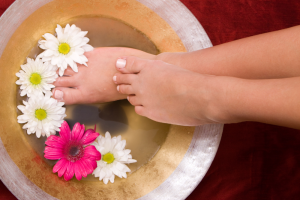Brain Shower Springtime Foot Guide For Diabetics
Come rain or shine, these foot care tips are essential for helping diabetes patients avoid common spring foot issues like blisters, excess moisture and sunburns.
Year-round care of your feet is essential if you’ve been diagnosed with diabetes, but springtime presents even more situations in which diabetics have to take extra special care of their feet. Decreased circulation, peripheral neuropathy and foot numbness are all possible side effects of diabetes and can create major issues if the feet aren’t properly taken care of. For example, a blister from a pair of strappy spring sandals or a puncture from a hidden stone in the grass can go unnoticed by a diabetic patient due to loss of sensation in the feet. The wound can then get infected, will most like be slow or even impossible to heal, and could lead to gangrene or even amputation. That is the worse case scenario, of course. But it just goes to show that diabetics can never be too careful when it comes to the health of their feet. So, without further adieu, here are some simple steps diabetics should take to keep their feet happy and healthy during springtime and beyond.
Keep Your Feet Dry
Those April showers bring May flowers, but the constant wetness can also bring dangerous diabetic foot issues, as well. If your foot skin is left wet for long periods of time in moist shoes or socks, the skin begins to wrinkle and break down, leaving it susceptible to infections like athlete’s foot and plantar warts. Therefore, you should always try to keep your shoes, socks and feet dry.
Avoid Walking Barefoot Outdoors
As tempting as it might be to feel the grass between your toes, doctors advise patients with diabetes to resist the temptation to walk barefoot outdoors. Small stones, sharp rocks, thorns and other potentially dangerous items can pierce or damage the foot, leading to ulcers and/or infection.
Slowly Work In Spring Sandals
Diabetics should always wear sturdy, comfortable shoes that fully protect the feet. However, on the rare occasion sandals are worn, be sure to slowly break them in by wearing them for only one to two hours a day until they’re comfortable. This will help you avoid blisters, corns and calluses that could get worse and cause dangerous issues like gangrene. Also be sure to use a hydrating foot lotion if you plan to wear sandals, as it can help ward off cracks in the skin and heel fissures that often come along with wearing seasonal shoes.
Avoid Spa and Salon Pedicures
Spring is the most popular season for pedicures, but diabetic patients should avoid the indulgent beauty treatment. No matter how fancy they might be, all spas and salons are breeding grounds for bacteria and fungus, especially when nail treatments are involved. Pedicures generally involve foot soaks, removal of foot skin with abrasive tools, curved nail trimming and other things that leave people with diabetes vulnerable to infections, ingrown toenails and more.
Use Sunscreen
Sunburns are dangerous for any human being, but they can wreak even more havoc for people with diabetes. Not only do burns stress your body, some experts believe they can raise blood glucose levels, which inhibits blood circulation and leads to a host of other diabetic issues. People often forget to use sunscreen on their feet, so be sure you slather SPF all over your body, including your soles and toes.
Keep Your Feet Warm
Diabetics often experience cold feet or a loss of sensation in the limbs that doesn’t allow them to feel hot or cold. Spring weather is often deceiving, with many people believing it’s a lot warmer than it actually is. Keep your feet at the right temperature by wearing moisture wicking socks when possible.
Incorporate Light Exercise Into Your Day
Spring is the perfect time to add some healthy exercise into your daily routine, which helps keep blood circulation flowing, your blood glucose levels in check and your immune system working strong. Try walks in your neighborhood, light jogging or swimming — but be sure to wear proper athletic shoes that fit well so you avoid things like blisters and Achilles tendonitis. And if you go to the pool, doctors recommend you wear flip flops when out of the water to avoid fungal infections.
Follow A Daily Foot Care Routine All Year Long
In addition to following the above springtime foot care tips, people with diabetes should adhere to a daily foot care plan. Typical steps include inspecting the feet every day, washing and drying the feet on a daily basis, properly trimming toenails straight across (never curved), wearing sturdy, comfortable shoes, and controlling glucose and blood sugar levels. For more information on how to incorporate a healthy foot schedule into your routine, speak with your podiatrist or check out our article Simple Steps To Prevent Diabetic Foot Problems.
Notice concerning medical entries:
Articles having medical content shall serve exclusively for the purpose of general information. Such articles are not suitable for any (self-) diagnosis and treatment of individual illnesses and medical indications. In particular, they cannot substitute for the examination, advice, or treatment by a licensed physician or pharmacist. No replies to any individual questions shall be effected through the articles.






